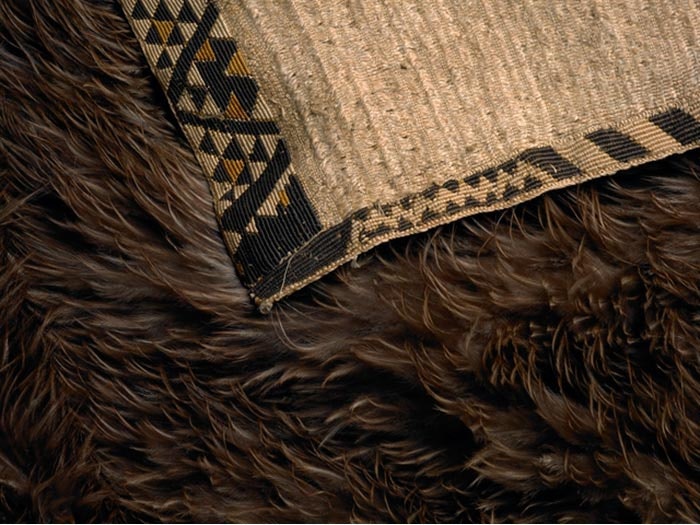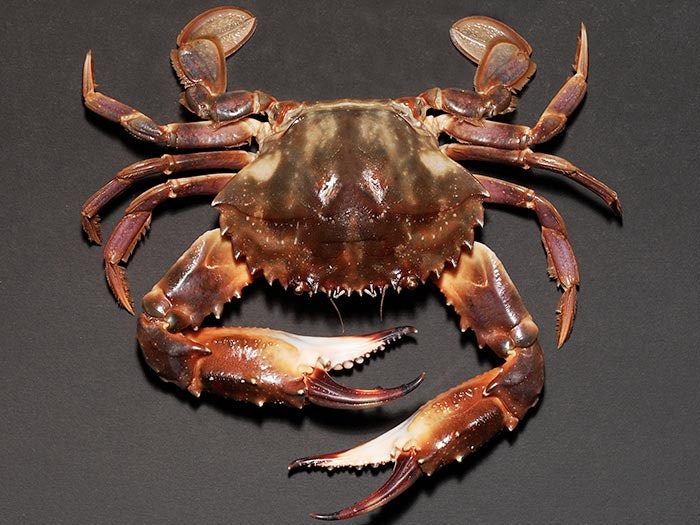
Tuhinga 22, 2011
Full Tuhinga issue 22 (9.03 MB)
Or download the individual article you’re interested in below.
A revision of the genus Pahoroides (Araneae: Synotaxidae) examines the genus Pahoroides, describes six new species, and redescribes two known species of tiny spiders unique to New Zealand.
Go to A revision of the genus Pahoroides (Araneae: Synotaxidae)
Archaeological investigations at Maungarei: A large Māori settlement on a volcanic cone in Auckland, New Zealand describes archaeological investigations of former Maori settlements on the volcanic cones of the Auckland area.
Go to Archaeological investigations at Maungarei: A large Māori settlement on a volcanic cone in Auckland, New Zealand
Exploring ‘the Rock’: Material culture from Niue Island in Te Papa’s Pacific Cultures collection examines Te Papa's Pacific Cultures collection of around 300 objects from the island of Niue. The article describes the history of the collection, the increasing involvement of the Niue community, and collecting possibilities for the future.
Go to Exploring ‘the Rock’: Material culture from Niue Island in Te Papa’s Pacific Cultures collection
Identification and description of feathers in Te Papa’s Māori cloaks documents the first scientific research undertaken to identify the feathers – to species level – contained in 110 kakahu (cloaks) held in Te Papa's Maori collections. The study identified the feathers of more than 30 species of bird, and provides insight into the knowledge required in using these materials in the cloaks.
Go to Identification and description of feathers in Te Papa’s Māori cloaks
Obituary: A tribute to Robert Louis Cecil Pilgrim (26 August 1921–7 April 2010), Research Associate, Museum of New Zealand Te Papa Tongarewa pays tribute to this teacher, biologist, and researcher who made an immense contribution to the scientific community in New Zealand.
Go to Obituary: A tribute to Robert Louis Cecil Pilgrim (26 August 1921–7 April 2010), Research Associate, Museum of New Zealand Te Papa Tongarewa
The podocarp Afrocarpus falcatus (Podocarpaceae) newly recorded as a casual alien in New Zealand examines the African podocarp Afrocarpus falcatus (Thunb.) C.N.Page. It is newly recorded as reproducing within New Zealand, only the second exotic podocarp recorded as reproducing autonomously in this country.
Go to The podocarp Afrocarpus falcatus (Podocarpaceae) newly recorded as a casual alien in New Zealand
Some terrestrial flatworm taxa (Platyhelminthes: Tricladida: Continenticola) of the Subantartic Islands of New Zealand reports on the study and revision of the Museum's collection of terrestrial flatworms from the New Zealand Subantarctic and other islands.
Go to Some terrestrial flatworm taxa (Platyhelminthes: Tricladida: Continenticola) of the Subantartic Islands of New Zealand
Annotated checklist of New Zealand Decapoda (Arthropoda: Crustacea) provides a checklist of the recent decapoda (shrimps, prawns, lobsters, crayfish, and crabs) of the New Zealand region. This checklist includes 488 named species in 90 families, with information on geographical distribution, habitat range, and in some cases, depth range and colour, given for each species.
Go to Annotated checklist of New Zealand Decapoda (Arthropoda: Crustacea)
A revision of the genus Pahoroides (Araneae: Synotaxidae)
Brian M. Fitzgerald and Philip J. Sirvid
ABSTRACT: The genus Pahoroides (Araneae: Synotaxidae: Pahorinae), endemic to New Zealand, is redescribed and revised. Two known species are redescribed and six new species are described (Pahoroides balli, P. kohukohu, P. confusa, P. gallina, P. aucklandica and P. forsteri). The original description of the type species, Pahoroides whangarei Forster, 1990, includes illustrations of the male palp of a second, undescribed species, described here as P. confusa. The genus is presently known only from the northern half of the North Island.
A revision of the genus Pahoroides (Araneae: Synotaxidae) (384.50 KB)
Archaeological investigations at Maungarei: A large Māori settlement on a volcanic cone in Auckland, New Zealand
Janet Davidson
ABSTRACT: Salvage excavations on the volcanic cone of Maungarei between 1960 and 1972 revealed a complex history of terrace construction and use, reflecting repeated occupations in the sixteenth and seventeenth centuries CE. The crater rim was extensively modified in the eighteenth century, after which use of the site seems to have ceased. Occupation of the cone was probably prompted by the need for defence, but it appears that only the two high points of the rim were actually fortified. A major use of the terraces was for roofed storage pits for garden produce. Artefacts are typical of what is known of Auckland area material culture, showing reliance on local rocks of the Waipapa series for adzes, although obsidian was imported from five source areas. Food remains reflect a reliance on fish and shellfish for protein. The predominant fish catch was snapper, with a remarkable size range suggesting a variety of capture methods. Charcoal and mammal and bird identifications are described in specialist appendices. The charcoal and faunal remains show that the local environment was already highly modified by Māori when the northern slopes of Maungarei were occupied. Maungarei meets the criteria for a transient settlement. Although the Auckland volcanic cones are usually perceived as exceptionally large sites, with populations numbering in the thousands, it is argued that the population of Maungarei at any one time would have been no greater than the number that could take refuge in, and defend, the larger of the two citadel areas.
Archaeological investigations at Maungarei: A large Māori settlement on a volcanic cone in Auckland, New Zealand (2.67 MB)
Exploring ‘the Rock’: Material culture from Niue Island in Te Papa’s Pacific Cultures collection
Safua Akeli and Shane Pasene
ABSTRACT: The Pacific Cultures collection of the Museum of New Zealand Te Papa Tongarewa (Te Papa) holds around 300 objects from the island of Niue, including textiles, costumes and accessories, weapons, canoes and items of fishing quipment. The history of the collection is described, including the increasing involvement of the Niue community since the 1980s, key items are highlighted, and collecting possibilities for the future are considered.
Exploring ‘the Rock’: Material culture from Niue Island in Te Papa’s Pacific Cultures collection (1.30 MB)
Identification and description of feathers in Te Papa’s Māori cloaks
Hokimate P. Harwood
ABSTRACT: For the first time, scientific research was undertaken to identify the feathers to species level contained in 110 cloaks (kakahu) held in the Māori collections of the Museum of New Zealand Te Papa Tongarewa (Te Papa). Methods of feather identification involved a visual comparison of cloak feathers with museum bird specimens and analysis of the microscopic structure of the down of feathers to verify bird order. The feathers of more than 30 species of bird were identified in the cloaks, and consisted of a wide range of native and introduced bird species. This study provides insight into understanding the knowledge and production surrounding the use of materials in the cloaks; it also documents the species of bird and the use of feathers included in the cloaks in Te Papa’s collections from a need to have detailed and accurate museum records.
Identification and description of feathers in Te Papa’s Māori cloaks (1.48 MB)
Obituary: A tribute to Robert Louis Cecil Pilgrim (26 August 1921–7 April 2010), Research Associate, Museum of New Zealand Te Papa Tongarewa
Ricardo L. Palma
Obituary: A tribute to Robert Louis Cecil Pilgrim (26 August 1921–7 April 2010), Research Associate, Museum of New Zealand Te Papa Tongarewa (207.91 KB)
The podocarp Afrocarpus falcatus (Podocarpaceae) newly recorded as a casual alien in New Zealand
Leon R. Perrie
ABSTRACT: The African podocarp Afrocarpus falcatus (Thunb.) C.N.Page is newly recorded as reproducing within New Zealand. Numerous seedlings were found directly beneath a mature female tree in Palmerston North. Within New Zealand, A. falcatus clearly fits the ‘Cultivation Escape’ subcategory of the Casual Record list, and it is easily distinguished from other podocarps by the yellow-orange colour and large size of its mature seed cones, its relatively thin, flaky bark, and details of the leaves.
The podocarp Afrocarpus falcatus (Podocarpaceae) newly recorded as a casual alien in New Zealand (561.01 KB)
Some terrestrial flatworm taxa (Platyhelminthes: Tricladida: Continenticola) of the Subantarctic Islands of New Zealand
Leigh Winsor
ABSTRACT: Within the context of ongoing taxonomic revisions of terrestrial flatworms from the New Zealand Subantarctic Islands: (1) a new tribe Argaplanini is erected; (2) a new genus Argaplana is erected; (3) the species Argaplana ranuii is redescribed; and (4) the replacement name Marionfyfea is proposed for Fyfea, pre-occupied.
Some terrestrial flatworm taxa (Platyhelminthes: Tricladida: Continenticola) of the Subantartic Islands of New Zealand (560.91 KB)
Annotated checklist of New Zealand Decapoda (Arthropoda: Crustacea)
John C. Yaldwyn and W. Richard Webber
ABSTRACT: checklist of the Recent Decapoda (shrimps, prawns, lobsters, crayfish and crabs) of the New Zealand region is given. It includes 488 named species in 90 families, with 153 (31%) of the species considered endemic. References to New Zealand records and other significant references are given for all species previously recorded from New Zealand. The location of New Zealand material is given for a number of species first recorded in the New Zealand Inventory of Biodiversity but with no further data. Information on geographical distribution, habitat range and, in some cases, depth range and colour are given for each species.
Annotated checklist of New Zealand Decapoda (Arthropoda: Crustacea) (1.47 MB)
